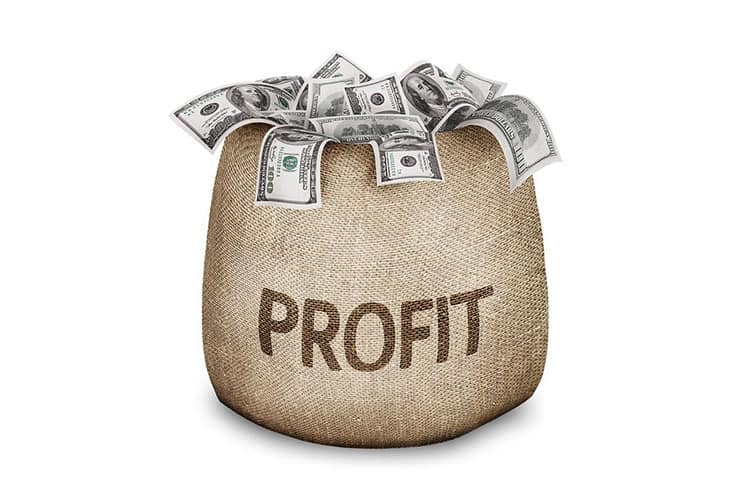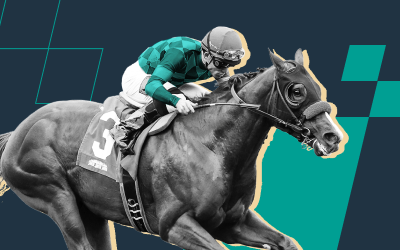Overround is the sum total of all the odds on the outcome of a single event. Its purpose is to create a profit margin for the bookmakers that ensures they make a profit regardless of the outcome. In this guide, you'll find a payout calculator and which bookies are best for fair payouts.
- Best Betting Sites We Recommend for Better Overrounds in 2024
- Margin and Payout Calculator
- Overround, Margin & Payout in Betting Explained
- Why Does a Bookie Need Overround?
- How Does a Bookie Achieve Overround?
- Calculate The Overround, Examples & Shop Around
- How You Can Use Overround For Arbitrage Betting
- Hedging With Betting Exchanges Using Overround
- Other Common Betting Terms
- ThePuntersPage Final Say
- Overround Explained & Betting Margin Calculator FAQs
Best Betting Sites We Recommend for Better Overrounds in 2024
Bet £10 Get £30 18+. Min deposit requirement. Free Bets are paid as Bet Credits and are available for use upon settlement of qualifying bets. Min odds, bet and payment method exclusions apply. Returns exclude Bet Credits stake. Time limits and Full T&Cs apply. Bet Responsibly. BeGambleAware.org #ad
|
Bet £5 Get £20 18+ New Customers Only. Opt in and bet £5 on sports (odds 2.00+) within 7 days. No cash-out. Get 4x£5 Free Bets for set markets, which expire in 7 days. Selected payment methods only. Full T&Cs apply. Bet Responsibly. BeGambleAware.org #ad
|
Margin and Payout Calculator
Add prices of events into the ovveround margin calculator to get the overround percentage of the market.
To use the table simply enter your odds, either decimal, fractional, or American, and the calculator will automatically display the margin and payout so you can get an idea of the value on offer.
Overround, Margin & Payout in Betting Explained
Overround is vital to a bookmaker’s business because it prices markets overwhelmingly in their favour. This is because it is designed to guarantee that the bookmakers will still post a profit even if all of the event factors are equal.
Bookmakers, like all trades, are in business to make money but they also exist because they allow people to enhance their sporting enjoyment. One of the reasons they are able to guarantee themselves a profit or eliminate the threat of making a severe loss is through an event odds overround.
What Is Overround Betting?
When all of the odds of an event are multiplied together there should, because of the pre-factored in margin, be an additional percentage which we call the overround. It is a very important factor within the betting industry and is a very good indicator as to how much value there is in any specific market. The bigger the overround, the further from the true odds the market in question is likely to be.
What is Payout in Betting Terms?
A payout is the amount of return a punter will win after a successful wager. This return is made up of all of the winnings a bettors has won, i.e. his or her profit, plus their original stake which is retuned in full. If a player wins on a £10 5/1 wager, then they can expect to win £50 but their payout will be £60 because of the £10 stake that is included in the final return.
Why Does a Bookie Need Overround?
For the most part, the odds offered by bookmakers are very seldom reflective of the true odds because they will always factor in a margin to cover their overheads. This is essentially their safety net and the lifeblood of their business model. So, when bookmakers are pricing up their odds for an event, they will factor in a margin on top. Then, when they come to add together all of the odds they have drawn up, the final, exaggerated figure will breach 100% and that surplus is what we call the overround which the bookies rely on to stay in business.
How Does a Bookie Achieve Overround?
Overround betting is the lifeblood of any good sportsbook worth its salt but, such is the meaning of overround, it can be applied for anything where chance plays a part. Take this simple formula for calculating the betting overround for something as basic as a coin toss.
Heads = Probability 50% = (True) Odds (1/1) 2.00
Stake = £50
Tails = Probability 50% = (True) Odds (1/1) 2.00
Stake = £50
Total staked = £100
Total Payout = £100
Profit/loss = £0
This rounded book, minus the extra margins, does not rely on two or more outcomes having an equal probability as with the above example of the toss of a coin. Eliminating in theory the possibility of a tied outcome, a football match will, in the main, be played out between two teams of uneven ability so we will rate the two teams differently.
So, let’s say Team A is a 6/4 shot versus Team B at 4/6.
The implied probabilities are thus
Team A: 6/4 = 2.50 = 40%
Team B: 4/6 = 1.67 = 60%
So far, we have not yet added our bookmakers overround.
If £50 was again staked on each outcome at these odds and Team A wins at 6/4, the bookie’s liability would be £25
Total staked = £100
Total payout = £125
Liability = -£25
If Team B wins at 4/6, then the bookie’ would make a profit of £16.67.
Total staked = £100
Total payout = £83.33
Profit = £16.67
In the above scenario, the bookie may make a profit of £16.67 or they could also take a hit of £25. The risk of taking such a hit will obviously be unacceptable to a bookmaker, hence the need for the overround. And because of this overround, the bookmaker can ensure that, at the very least, they can balance the book and break even no matter the outcome.
To achieve this, the bookie is therefore required to take different amounts of stakes on either side of the market.
In this case, the bookie would have to limit the amount of stakes they take on Team A, relative to Team B in order to balance the book. That would look something like this:
Team A
6/4 = 2.50 = 40%
Total stakes on A = £40
Total payout if A wins = £100
Team B
4/6 = 1.67 = 60%
Total stakes on B = £60
Total payout if B wins = £100
So no matter what the outcome here is, the total staked would be £100 and the total liability would be £100 providing the bookmaker with a rounded book that removes the risk and ensures they break even. But bookmakers are not in business to break even. Sure, it’s better than taking a loss but they are in operation to take your money and turn a regular profit.
That’s where overround comes in. to that end, here’s a simple illustration of how the bookmaker creates and then employs the overround.
As we’ve seen, ‘true’ odds require the sum of all possible probabilities to add up to 100%. A straightforward Win/Draw/Win market looks like this with the following odds and implied probability:
Team A: 23/10 = 3.30 = 30.3%
Draw: 23/10 = 3.30 = 30.3%
Team B: 6/5 = 2.20 = 45.5%
The sum of all three implied probabilities is therefore:
30.3% + 30.3% + 45.5% = 106%
Here, you can see that the sum is over the rounded book figure by 6%. Well, this extra 6% is the overround and, as a general rule, anything below 10% is considered a good betting opportunity.
So, using the example above, for every £100 staked on this market, the bookmaker is guaranteed a profit of £6 no matter the outcome. They protect this margin by ensuring that they keep a rounded book by sticking to the appropriate ratio of stakes on each of the three possible outcomes based on the implied probabilities above.
What we have outlined here is a fairly simplistic introduction to the concept of overround. But, remember, bookies do not come to play and, in order to generate their overround figures, they employ complex models and state of the art, up to date technology.
This is when market movement will be triggered, as bookmakers offer more attractive and generally longer odds on the opposing sides of the market in order to tempt more punters in to re-balance the book.
Calculate The Overround, Examples & Shop Around
The betting overround is not always the same. Our very own overround produced a figure of 6% but that doesn’t mean that all overrounds will be this number. In fact, overround scores can and do vary wildly between different firms and markets. It is also important to note that for multiple selections and accumulators, the overround is compounded by each additional selection. It’s not 6% of the whole, but rather is added for each of the selections individually.
Assuming that the overround of each component selection remains the same 6%, a double bet works out as 6% + 6% = 12%. For a treble, that formula becomes 6% + 6% + 6% = 18%, and so on. Now you can see why bookmakers love accumulators.
It’s also vital to compare prices on different markets, and with them their factored in overround, so that you will be able to see who is publishing closest to the real odds. Consider the following examples of different markets offering different prices with varying levels of overround on essentially the same bet.
You can use the overround calculator above in order to help you with your calculation.
If we break these bets down to calculate the overround, with the help of our odds converter calculator, we see the following:
Overround Example #1: Draw no Bet
Team A: 5/4 = 2.25 = 44.4%
Team B: 4/7 = 1.571 = 63.6%
Sum of implied probabilities = 108%
Overround = 8%
Overround Example #2: European Handicap Tennis
In a match between Rafa Nadal and Roger Federer, the bookmaker may offer a price of Evens on Nadal with a European handicap of +3.5 games. If we add the odds of Nadal + Federer and we cannot have a tie, then that is our only available calculation.
Overround Example #3: Alternative Asian Handicap
Team A: 0.0: 13/10 = 2.30 = 43.5%
Team B: 0.0: 3/5 = 1.60 = 62.5%
Sum of implied probabilities = 106%
Overround = 6%
As you can see the Draw No Bet market comes with an overround of 8%.
The overround on the Alternative Asian Handicap market is a more favourable 6% in this case. The difference can be seen more clearly however if we compare the potential returns on a £10 wager.
Overround Example #4: Team A – Draw no Bet
Wins if Team A win, returns your stake in the case of a draw and loses if Team B win. £10 staked on Team A DNB at 5/4 returns £22.50, a profit of £12.50.
Overround Example #5: Team A 0.0, Alternative Asian Handicap
Wins if Team A win, returns your stake in the case of a draw and loses if Team B win (i.e. the same bet). This time you’ve staked £10 on Team A 0.0 at odds of 2.30. If this bet wins, your return is £23.00, a profit of £13.00.
So £10 staked on different bets, but with the same outcome, will either return you a profit of £12.50 or £13.00. Only a 50p difference, granted, but that 50p is still 5% of your initial stake and is always better in your pocket rather than the bookies’. Plus, imagine that 5% on all of your stakes. It soon mounts up, so be aware.
How You Can Use Overround For Arbitrage Betting
Arbitrage betting is a gamblers’ technique in which they bet on all of the possible outcomes, however likely or unlikely. It works best with sporting events where there are only two potential outcomes. Because of this, one versus one games where one of the two opponents must win, such as tennis, are particularly well suited to this method. While arbitrage betting is not a new system, the boom in internet gambling and online software has allowed arbitrage betting to grow ever popular much to the annoyance of bookmakers who do not welcome arbitrage betters. One more thing about arbitrage betting is that it is a mathematical process that doesn’t require those employing it to maintain any interest in the sport they're betting on. Generally speaking, arbitrage betting should guarantee a profit but, because it mainly works on two outcome events and you are backing the loser and the winner, bettors need to place large bets in order to generate any profit or avoid a loss.
Arbitrage Betting Example
Because of the way bookmakers price up their markets using overround, you are guaranteed to lose money just by betting on each outcome in an event with the same bookmaker. So, when hunting for the possibility for arbitrage, we need to find opportunities where all outcomes from different bookies add up to less than 100%.
To calculate the arbitrage percentage, you can use the following formula:
Arbitrage % = ((1 / decimal odds for outcome A) x 100) + ((1 / decimal odds for outcome B) x 100)
Rafa Nadal Win: (1 / 1.18) x 100 = 84.746%
Nick Kyrgios Win: (1 / 7.00) x 100 = 14.286%
84.75% + 14.29% = 99.032%
In the Men’s Tennis example above with two different bookmakers, the formula works out at less than 100% making it ripe for an arbitrage bet.
Hedging With Betting Exchanges Using Overround
Betting exchanges differ from traditional sportsbooks because they allow punters to be the bookmaker and lay bets in a peer to peer platform. With these betting exchanges, you are betting against other people and not a traditional bookmaker or sportsbook. On a betting exchange you can request a higher price than has been published in a sportsbook and so long as someone else lays the bet by agreeing to meet your challenge, your bet will have been matched. On the betting exchanges people can set their own betting odds so we have eliminated the bookie’s overround. For more complex minded bettors, these exchanges also enable arbitrage opportunities, again to cover all possible outcomes and guaranteeing a profit no matter who wins. This risk reducing trading strategy is known as hedging your bets and works as a form of insurance, designed to protect your existing bets against potential losses. Generally speaking, the overround will be lower on peer to peer betting exchanges than it is with the high street or online bookmakers. That said, betting exchanges make their money by taking a small and fair commission which is worth remembering. For example, betfair’s commission is calculated using a market base rate of 5% and only applied to net winnings, while the commission deducted by Smarkets is 2% on their standard tier and 3% for customers who exceed £25,000 in net profit over the year. For players that place over 1,500 bets or stakes more than £1 million in a year, a special rate of commission of 1% will be applied.
Hedging Example
To clarify what we mean, let’s take a look at what would happen if we bet on both players to win the same tennis match. Here’s the market for an upcoming match between the same players from our arbitrage example:
Rafa Nadal Win (1.50)
Nick Kyrgios Win (11.00)
Our main issue is how much we should consider hedging. Our aim should be to work out what would happen if we backed Nadal with half of the potential profit from winning Kyrgios, £500 should do it. If we put £100 on Kyrgios at his log price as well, we would have a total outlay of £600.
This would give us a total outlay of $600. We have got £100 on Kyrgios at odds of 11.00 plus £500 on Nadal at 1.50 meaning:
Nadal wins: £750 (£250 total profit)
Ferrer wins: £1,100 (£500 total profit)
Other Common Betting Terms
ThePuntersPage Final Say
Betting Overround is the tool that the bookmakers use in order to give them a built-in, risk-free profit margin. At the end of the day, while many bettors do not give it a thought, understanding overround calculation and how betting odds work is undeniably beneficial when it comes to making money through betting. Such a dismissive attitude could prove to be foolish because knowing the what, why and how of overround will give you a far greater understanding of how the odds of your chosen bet compare to the true odds and likelihood of your predicted outcome.
Overround Explained & Betting Margin Calculator FAQs
Overround, put simply, is the surplus value that has been calculated by adding together all of the outcome odds.
Yes, we keep it at the top of the table so that it is easy to find, use and understand.
You sure can, by calculating all the actual probabilities to remove the overround and bring all the total implied probabilities to back to 100% you will have a clean line.
While these are not the same thing, overround only exists because of the margins so they are simpatico.
Two team sports such as NFL Football, College Football, MLB Baseball, NBA Basketball, NHL Hockey and Football are generally considered to be good for betting margins. American sports in particular are good because many of them rule out the possibility of a draw. eSports are also known to have very good margins in their 2-way bets and is an ever growing market within bookmaking.
This is a simple case of shopping around and doing your research. Plus, it is always worth looking at the true likelihood of an outcome to see how honest the bookies’ prices really are














